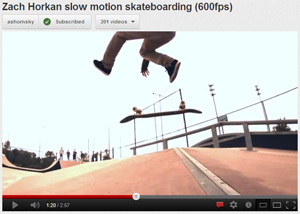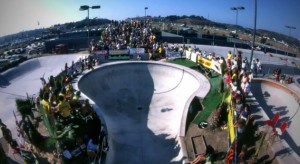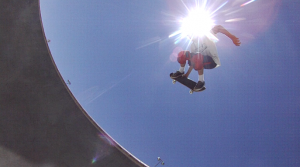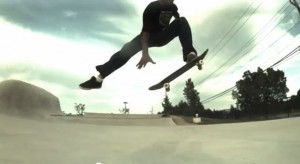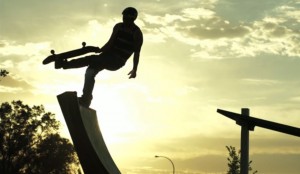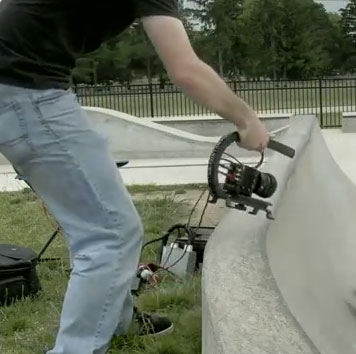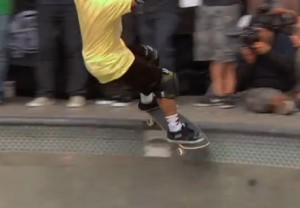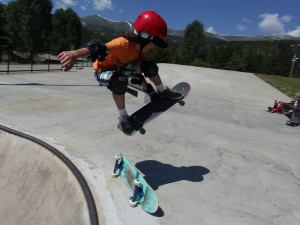
Parents with kids who are new skateboarders often wonder about starting them out safely, and without injury. After getting kids a proper skateboard, helmet and pads from a specialty skateboard shop or good online retailer, it’s a great idea to introduce them to some of the basic fundamentals, to get them started right.
First, you should know that it’s possible to buy a “toy” skateboard from a sporting goods store or big-box retailer, that doesn’t turn well, has “slower,” sticky bearings, and isn’t as durable as a real skateboard. Don’t go this route. It’s always a good idea to buy a skateboard manufactured by a skateboard company, preferably from a specialty shop or online store. Online, Skates has everything you need. [Note: This post has some great information about buying skateboard equipment for kids.]
Skateboard Foot Position
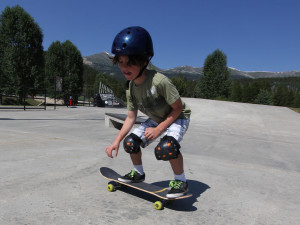
You can show your new skateboarder where to put his or her feet for the best balance and maneuverability on their skateboard. Teach them to step on and off the board with the back foot, while keeping the front foot planted on the board over the truck bolts. The back foot is placed on the tail, to create leverage for lifting the nose for steering, kickturns, ollies and other tricks. With both feet pointed across the board and most of the weight on the balls of the feet, the skater should be able to roll and steer on a flat surface. But what about getting the skateboard moving on their own?
Pushing a Skateboard
I mentioned leaving the front foot on the skateboard while stepping on and off – and this is the way to push a skateboard too – by keeping the front foot on the board, the skater can take the back foot on and off the tail without moving the front foot to a different place on the skateboard. Teach the skater to start with the front foot pointed towards the front of the board, pushing off the ground with the back foot , and then placing the back foot on the tail and rotating the front foot back to the “across the board” position. Some new skaters teach themselves to push “mongo,” which is pushing the board with the front foot. This requires an extra movement of the back foot, to get it off the tail of the skateboard, and is considered “the wrong way” by most skaters.
Stepping Off the Skateboard
Once a skater knows how to push and stand on the rolling skateboard, they should learn how to get off the board safely. Just like when stepping on or off the static, non-moving board, skaters should learn to take their back foot off the board first. This prevents the front of the board from coming off the ground, and the movement allows for quick egress from a rolling skateboard – sometimes a needed move! Have new skaters practice pushing and then stepping off in front of the moving skateboard, shooting the board back behind them and taking a few steps. If they can get used to stepping off the board in this way, they’ll be able to “bail” or get off their boards without crashing, which leads to faster learning and more new tricks!
Two Ways to Steer a Skateboard
There are two ways to steer a skateboard: by tilting the board and letting the trucks do the work, and by lifting the front wheels off the ground and rotating the board on the back wheels. The first is called carving, and the second is a kickturn. Teach a new skater both ways of steering, by letting them roll slowly on a flat surface and trying to turn back and forth by leaning. If a new skater’s trucks are too tight, they may not be able to turn very easily. Loosen the kingpin nut on each truck a little bit to free up the skateboard’s turning ability. A half-turn to start is a good amount. You can also replace the bushings in a skateboard truck – softer bushings are available at most shops. For the kickturn, have them practice lifting the nose of the board up while staying in balance, without moving. You can start a new skater out on carpet, or on the grass, before moving to the driveway or skatepark surface, to give them a feel for staying over the board while lifting and setting down the front wheels. Then, once they are used to the movement, have them rotate their arms a little bit in one direction, and then the other, while lifting the front wheels, to get the board to turn. Finally, while moving slowly on a smooth surface, they can get the feel of turning the board by performing the kickturn movement.
Roll up a Ramp to Fakie
The term Fakie in skateboarding means “rolling backwards.” So, if you have a slight hill in the driveway, or a mellow ramp or bank at the local skatepark, get the new skater to roll up the feature, and then let gravity take them back down to fakie. Practicing this will help them to align their body to the ramp or hill, and work on balance for their future tricks.
These five fundamentals are some of the key ingredients that come into play during every trick in skateboarding. If new skaters can master these five quickly, they’re well on their way to becoming a safe and progressing new skater. They’ll be learning new tricks and inventing their own in no time.
